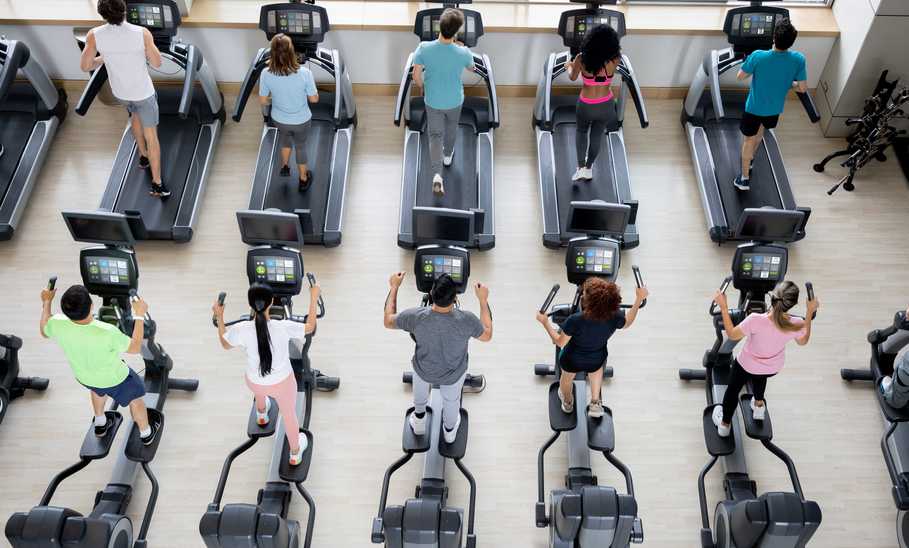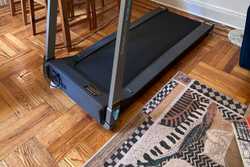Treadmill vs Elliptical: How to Choose the Right Machine For Your Fitness Needs

Our evaluations and opinions are not influenced by our advertising relationships, but we may earn a commission from our partners’ links. This content is created by TIME Stamped, under TIME’s direction and produced in accordance with TIME’s editorial guidelines and overseen by TIME’s editorial staff. Learn more about it.
If you’ve ever set foot in a big-box gym, you’ve probably noticed how much real estate is dedicated to treadmills and elliptical machines. And it’s for good reason. “They offer a low-barrier entry into fitness, provide excellent cardio workouts, and burn calories effectively,” says fitness expert and powerlifting coach Nikolai Puchlov, creator of Pro Kettlebell. “Almost anyone can use them, and they are often the go-to machines for people looking to improve their health.”
But which machine is best for you? That’s the question I’m tackling here. Read on to discover the pros and cons of treadmills and ellipticals, plus the factors to consider when choosing the one that best fits your needs.
Exercising on a treadmill provides numerous perks for your health and fitness. Here are some of the biggest ones.
Treadmills are primarily thought of as cardio machines, so this one is no surprise. “Running or walking on a treadmill improves cardiovascular health by increasing heart rate and promoting blood circulation,” explains former Mr. America and Los Angeles personal trainer Jason Kozma. These perks will translate into better endurance in your daily life.
If weight loss is your goal, a treadmill is going to help—regardless of the speed at which you set it. “Using a treadmill will make you burn more calories, helping with weight loss and fat reduction,” Kozma says. Treadmills have almost no barriers to entry. Even people who are new to fitness and are simply trying to fit more steps into their day as they work towards a lower number on the scale can benefit from getting on and walking.
“Weight-bearing exercise like running or walking on a treadmill strengthens bones, reducing the risk of osteoporosis,” says Kozma. Indeed, the Bone Health and Osteoporosis Foundation touts weight-bearing exercises—including high-impact ones like jogging and running, and low-impact ones like walking, both of which you can do on the treadmill—as key strategies for helping build and maintain bone density.
“Treadmills allow you to walk, jog, run, or sprint, offering a wide range of cardio workouts,” says Puchlov. “With speed and incline adjustments, users can tailor their workouts to their fitness level and goals.” From beginner exercisers to seasoned runners, anyone can get a workout on a treadmill that will be challenging and fit seamlessly into their workout regimen.
While treadmills clearly offer many benefits, there are also some drawbacks to consider.
It’s true that weight-bearing exercise is good for you, but working out on a treadmill (especially at higher speeds) can be hard on the joints. “Running on a treadmill can put stress on the joints, particularly the knees, hips, and ankles, which might lead to injuries over time,” says Kozma. While a treadmill belt is a softer, gentler surface than pavement, too-frequent treadmill runs can still do damage to the joints.
The risk of injury with a treadmill is two-fold. First, there’s the risk that comes with the workout. “Continuous running on a treadmill can lead to repetitive stress injuries, particularly if the belt is moving faster than the user can handle,” notes Puchlov.
Then there’s the risk that comes with the machine itself, which, according to the U.S. Consumer Product Safety Commission, injures more people per year than any other piece of exercise equipment. These possible injuries, which include strains, sprains, burns, and concussions, typically happen when a user stumbles or falls and the belt keeps running beneath them.
“Traditional motorized treadmills often require regular maintenance and repairs,” says Puchlov. “This can be frustrating and costly.” Considering the fact that treadmills are one of the more expensive exercise machines, they can end up being quite the investment.
Even folding treadmills have a large footprint and not everyone has the space required for this machine.
Then there’s the elliptical, which some people see as the treadmill’s gentler cousin. Here are some of the perks to working out with one.
Unlike the treadmill, the elliptical is totally low-impact. “Ellipticals offer a smooth, gliding motion that reduces stress on the joints, making them ideal for those with joint issues,” explains Puchlov. The low-impact nature of the elliptical also makes it a great pick for people recovering from injury, and beginner exercisers.
“Unlike treadmills, ellipticals engage both the upper and lower body, working muscles in the arms, shoulders, chest, back, and legs,” says Kozma. This makes the elliptical a one-stop shop and a more efficient workout if you’re short on time.
The elliptical offers a powerful form of cardio that will strengthen the heart and boost your heart rate to burn calories and fat. Since it’s a full-body workout, you’ll get a bit more muscle toning from the elliptical than you would on the treadmill, so it may help you trim inches a bit faster.
“Ellipticals are easy to use, and the motion can feel more controlled than running on a treadmill,” Puchlov says. Since the machine is moving with you and you’re holding onto the handlebars with your hands, you’re much less likely to suffer an injury from a slip or fall like you might on a treadmill.
Even though ellipticals offer many of the same perks as treadmills and then some, they also come with some negatives.
“While ellipticals are low-impact, they can limit your range of motion,” notes Puchlov. You can only make your strides as long as the machine allows, which can feel awkward for some people. “Some users find the motion of an elliptical less natural compared to walking or running, which may affect the workout experience,” adds Kozma. In this sense, ellipticals don’t offer the same amount of freedom of movement as a treadmill.
“Since ellipticals are low-impact, they don't provide the same bone-strengthening benefits as treadmill running or walking,” Kozma says. The elliptical is considered a low-impact, weight-bearing workout, so it does offer some perks as far as bone health, but certainly not as many as the treadmill.
Even though you probably won’t fall off, overuse injuries are a concern. “Similar to treadmills, the repetitive motion of ellipticals can also lead to joint strain over time, especially if users aren't mindful of their form,” Puchlov notes.
“Like treadmills, high-quality ellipticals can be expensive, and their more complex mechanics may require more maintenance,” says Kozma. Consider if it’s an investment you want to make.
As you can see, treadmills and ellipticals both have pros and cons. Before you make the final decision on which to invest in, my experts recommend considering the following factors.
Why are you trying to up your cardio? Are you training for a race or event, trying to lose weight, or simply looking to get fitter? These reasons will play a key role in your decision. “If your goal is to improve running performance or bone density, a treadmill might be better,” says Kozma. “If you're looking for a low-impact, full-body workout, an elliptical could be the better choice.”
If you’re worried about wear and tear on your joints or have a history of lower body injuries, the elliptical is likely the safer choice. But if you don’t have any concerns and you want those bone-building perks of weight-bearing movement, go for the treadmill.
“If you want a machine that offers a broader range of workouts (e.g., running, incline walking, HIIT), a treadmill may be more versatile,” notes Kozma. “Ellipticals offer full-body workouts but are more limited in variety.” Likewise, if you want a machine that allows for some mindless calorie burning, go for the elliptical. If you don’t mind being fully engaged throughout your workout, choose the treadmill.
Both machines can be quite large, but treadmills tend to be bigger and can be noisier. That said, you likely need a higher ceiling for the elliptical.
“Both machines can be expensive, so consider your budget and the long-term investment, including potential maintenance costs,” says Kozma. If you have a smaller budget, there tend to be more inexpensive options for ellipticals than treadmills.
| Factors | Treadmill | Elliptical |
|---|---|---|
Fitness goals | Best for running-specific goals, walking, and bone building | Best for low-impact, full-body, and general cardio |
Joint health and injury concerns | Best for no concerns | Best for protecting joints or returning from injury |
Workout preferences | More versatile and mindful | Less variety, can be mindless |
Space | Needs more length-wise | Needs more height-wise |
Budget | Generally more expensive and higher maintenance | Slightly less expensive but still high maintenance |
It can be difficult to choose between a treadmill and elliptical. Deciding to invest in a large piece of exercise equipment is a big commitment in the first place, and you don’t want to choose one you won’t use. “Ultimately, the best choice depends on your personal preferences, fitness goals, and any specific health concerns,” says Kozma. “If possible, trying both machines at a gym before purchasing can help make the decision easier.”
Either way, or even if you choose a different cardio machine like a stationary bike or stair climber, investing in the machine that you know you will use to improve your health is the best choice.
The information presented here is created by TIME Stamped and overseen by TIME editorial staff. To learn more, see our About Us page.



